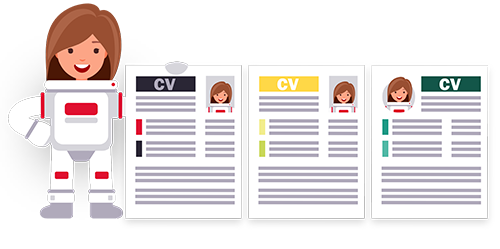Choose a template, customise it and save your CV as a PDF.
With our CV templates, you've already got a good foundation for your job application—now it's time to fill it in. We will show you what is important when writing your CV.
The Cvhero.com templates offer several benefits:
Recruiters usually have very little time to spend on job applications. Therefore, the relevant qualifications and work experience must be apparent at first glance. Only in the next step of the application process is it important to gain a deeper insight into the candidate's personality.
That’s why the CV should focus on information about work experience, education, and additional qualifications.
It is also important that your CV matches the industry you are applying for: If you are applying to a bank, you should choose a simple template, but if you are applying to an advertising agency, you can be creative.
We have listed the most important points to help you create your CV
A well-designed CV is usually no longer than two pages. Therefore, when applying for a job, you should only include the most essential information in your CV. This includes, in any case and in the following order:
All stages are divided into time periods in the CV and listed in reverse chronological order one below the other. It is common to place the date (e.g. 01/2019-09/2021) in a left-hand column of the CV and the corresponding activity on the right. Tip: Our CV editor offers you a very easy way to design your CV without any prior knowledge, using templates and examples.
You are welcome to go into more detail in the work experience section, as companies are particularly interested in your professional history, education, and experience in relevant industries. Depending on your work history, this section, including your personal details, can fill the entire first page. A candidate’s educational background is equally important to employers. Therefore, you should include your education in your CV. Your hobbies can also add value to your CV - as long as they are relevant to the job you are applying for or otherwise catch the recruiter’s eye.
Strictly speaking, employers in Germany are not allowed to ask you for an application photo - this has been decided by the legislature. However, we recommend adding a professionally taken application photo to your CV. In our guide to application photos, we explain what to look out for when taking a photo to make a good first impression.
We recommend that you include knowledge and skills in your CV that are relevant to the job you are applying for and that make you more qualified for the job in the eyes of a recruiter. Good language skills, especially German and English, are a plus for almost any job and are therefore a must in your CV. The skills section is usually included in the last section of your CV.
If you have language certificates, it is very easy to add them to your CV. Simply list them in bullet points according to your certificate:
Even if you don’t have any certificates, it’s worth including a self-assessment of your language skills in your CV. In this case, use phrases such as: Basic knowledge, Advanced knowledge, Fluent in spoken and written language, Business fluent in spoken and written language, Mother tongue (sorted from poor to very good). Your CV could then say, for example:
Some employers also ask for specific tests in job advertisements, such as the TOEFL test for English. So, in this job, you will probably spend a lot of time travelling abroad or work in an international team. If this is the case, be sure to mention your certificate on your CV and include a copy of the certificate with your application.
Please note: Work experience, i.e. the knowledge and skills you have acquired while working for previous employers, does not belong in this section at the end of your CV. It should be included under the section "Work Experience" on the first page of your CV.
CV is the abbreviation for the Latin "Curriculum Vitae" which translates to "course of one’s life". Depending on the country, different requirements will apply to the CV.
If, for instance, a British CV is desired, there are a few things you should keep in mind:
You do not have to write your CV in Word. It is true that Microsoft’s software also offers the possibility to create CVs with ready-made templates. But these templates have their drawbacks:
Many jobseekers complain that the CV templates in Word can only be customised to a limited extent. Only those who are sufficiently proficient in the programme can vary the text and graphic components of the template to suit their own profile. In addition, many of the Word templates are tailored to the American or international market, which means that important elements such as a pre-defined area for an application photo are missing from the templates.
We therefore recommend using our CV editor. With our templates and samples, you can create complete, step-by-step job applications tailored to the German job market - including cover letter, CV, and cover page. Our editor also allows you to add an application photo, create an elegant signature, change the template, and vary the font and colour.

Do you want to create your CV online? At Cvhero.com you will find many different CV templates that you can easily customise to suit your situation. You can choose from almost 30 templates, design your CV, and add your cover letter, cover page and attachments in the editor.
The CV templates are designed to be filled in and printed according to the standards commonly used in German HR departments. At the same time, our formatting gives you complete freedom: the cover letter, CV and cover page can be easily personalised and adapted to best reflect your career to date.